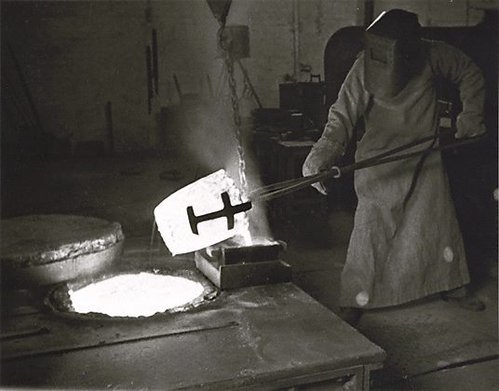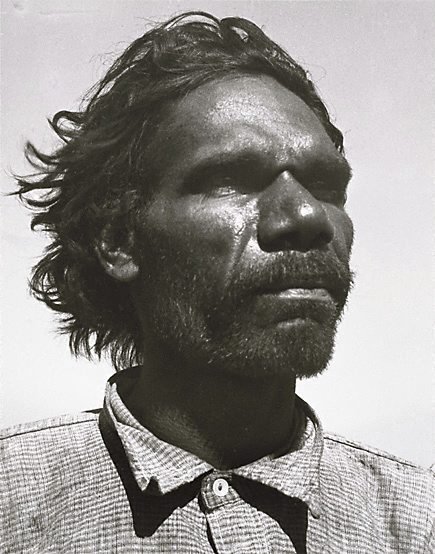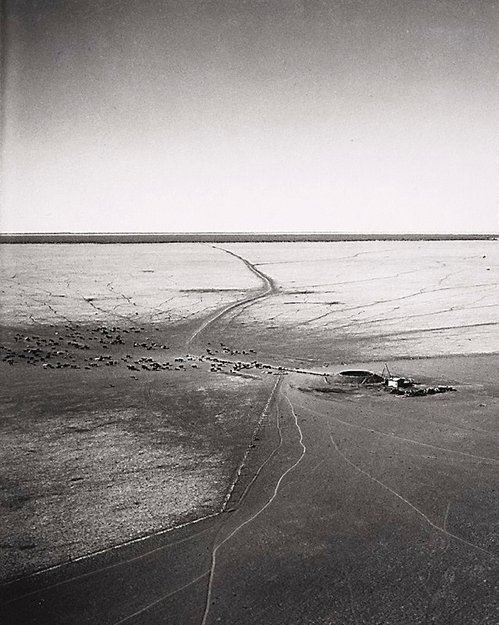Title
Storm over Kalgoorlie
1936
printed 1981
Artist
-
Details
- Dates
- 1936
printed 1981 - Media category
- Photograph
- Materials used
- gelatin silver photograph
- Dimensions
- 25.0 x 33.1 cm image (irreg.); 30.6 x 40.5 cm sheet
- Signature & date
Signed and dated l.r., pencil "Axel Poignant 1981". Dated c. verso, pencil "... 1936".
- Credit
- Purchased with funds provided by the Photography Collection Benefactors' Program 2011
- Location
- Not on display
- Accession number
- 242.2011
- Copyright
- © Courtesy Roslyn Poignant
- Artist information
-
Axel Poignant
Works in the collection
- Share
-
-
About
After his move to Australia in 1926, Axel Poignant’s life was marked by numerous hardships and tribulations that took him from Sydney – where he occasionally worked as a farmhand - to Western Australia. Beginning his professional career as a photographer in Perth, Poignant’s work evolved from studio portraiture to a steady engagement with photo-documentary. This was a consequence of some of the industrial commissions he received in mid 1930s and his disenchantment with the limitations of the conventional pictorialist approach.
During the late 1930s, Poignant felt a sense of dissatisfaction with the direction his work was taking and ‘abandoned all attempts to be “artistic” by externally imposed formulas’, directing his skills instead ‘to some useful purpose’.1 ‘Storm over Kalgoorlie’ is an early sign of this shift towards more socially committed documentary photography. The image forms part of a photo-series – a format with which Poignant became fascinated with thanks to exposure to overseas photo journals. Conceived independently while the photographer was making portraits of schoolchildren in the gold-mining town, the bleakness of the scene relates the experience of living in a place which inevitably would perish once the mineral resources were exhausted. Indeed, when exhibited, Poignant added the following caption to the photograph (which was then titled ‘Miner’s homes’): ‘In the heavy storm of 1936 two children were drowned in a subway (ie. storm water channel) into which this drain empties.’2 This tragic undertone and the humanism, coupled by the sharply realistic aesthetic of the photograph were rare in Australian photography of the time. Despite the lack of interest from magazines (only a few postcards from the series were produced) this early interest in reportage strengthened and led to Poignant’s remarkable images from The Canning stock route and Arnhem Land.
1. Quoted in Gael Newton, ‘Axel Poignant: photographs 1922-1980’, Art Gallery of New South Wales, Sydney, 1982 p 7
2. Gael Newton, 1982 p 34 -
Exhibition history
Shown in 3 exhibitions
Axel Poignant: photographs 1922-1980, Art Gallery of New South Wales, Sydney, 17 Jul 1982–29 Aug 1982
Axel Poignant: photographs 1922-1980, Art Gallery of Western Australia, Perth, 07 Sep 1982–08 Oct 1982
Axel Poignant: photographs 1922-1980, Flinders University City Gallery, Adelaide, 11 Nov 1982–01 Dec 1982
Axel Poignant: photographs 1922-1980, National Library of Australia, Canberra, 04 Mar 1983–08 Apr 1983
Axel Poignant: photographs 1922-1980, Museum of Brisbane, Brisbane, 04 May 1983–04 Jun 1983
Axel Poignant: photographs 1922-1980, Fine Arts Gallery University of Tasmania, , 08 Jul 1983–07 Aug 1983
Axel Poignant: photographs 1922-1980, National Gallery of Victoria [St Kilda Road], Melbourne, 25 Oct 1983–27 Nov 1983
Axel Poignant: photographs 1922-1980, New South Wales House, London, 05 Jun 1984–03 Aug 1984
Axel Poignant: photographs 1922-1980, Ikon Gallery, Birmingham, Birmingham, 11 Aug 1984–01 Sep 1984
Axel Poignant: photographs 1922-1980, Manchester Museum, , 01 Oct 1985–31 Dec 1985
Axel Poignant: photographs 1922-1980, Mansfield Museum, , 09 Jan 1986–04 Feb 1986
Axel Poignant: Australien-Land Och Människor, Kulturhuset, Stockholm, , 18 Nov 1988–09 Jan 1989
Picture story. Axel Poignant: the formative years 1929-1942, The Cross Art Projects, Kings Cross, 05 Feb 2011–12 Mar 2011




